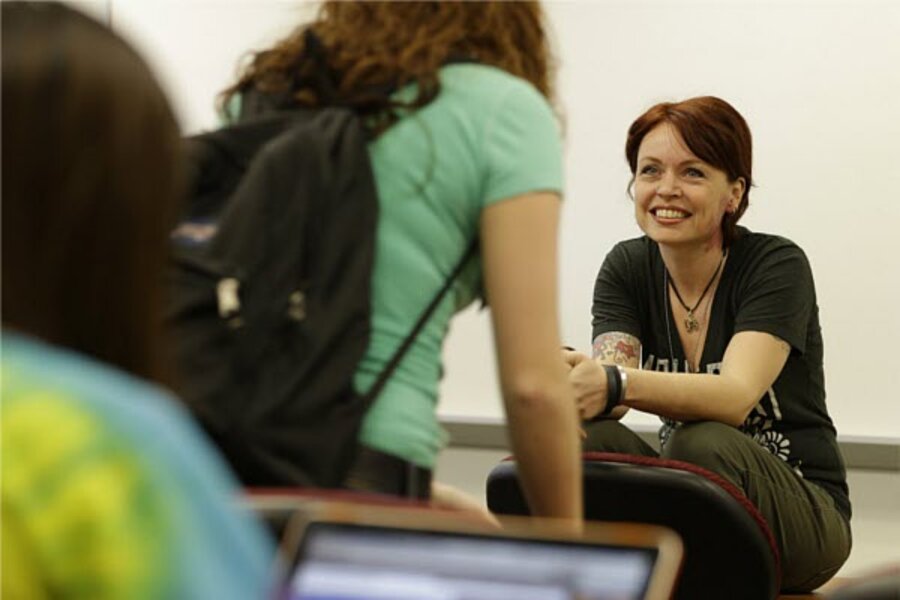Study: Community colleges lack rigor, but incoming students ill prepared
Loading...
There’s been a lot of talk lately of college- and career-readiness for high-school graduates, but according to a study released Tuesday, what community colleges actually require is less rigorous than we think – and many high school graduates aren’t meeting even those low standards.
What is being taught and emphasized in high school math and English, moreover, is out of alignment with what is needed to succeed in community college, the report concludes.
The study, from the National Center on Education and the Economy (NCEE), set out to look at what is actually required of first-year community college students – the textbooks they use, the work they’re assigned, the tests they’re given, and the grades they receive. By contrast, previous studies of student ability have relied on faculty surveys, which tend to emphasize what teachers wish their students knew.
Community colleges enroll nearly half of all college students in America, and are often a gateway both to four-year colleges and to vocational education. Thus, zeroing in on what’s needed for success at community colleges made sense, says Marc Tucker, president of NCEE and an author of the report.
“We’re talking about the preparation of people who are absolutely crucial to the future,” says Mr. Tucker.
Among the report’s findings, which looked at both math and English literacy:
• First-year community college students need to know fairly little math – and what they do need to know is mostly taught in middle-school math courses: arithmetic, ratio, proportion, expressions, and simple equations. Most high school graduates, however, don’t know it well. The typical college algebra course could be characterized as about the level of Algebra 1.25 – Algebra I and a few topics from geometry and statistics.
• Many community college courses require students to take complex measurements and to read schematic drawings and charts – concepts that aren’t taught at all in most high schools.
• In English literacy, most community-college texts were at an 11th- or 12th-grade level – but most students had not been reading texts at that level in high school, and were unable to analyze or comprehend them with any depth.
• Little writing is required in first-year community college courses, even though it’s an essential skill in many workplaces. A primary reason that faculty ask college students to write so little is that their writing skills are poor, and they did little writing in high school.
Clearly, says Tucker, standards are too low in both high school and community colleges if students are to be prepared for the careers they eventually hope to have.
“Because our workforce will have less skills than they need, it’s a bad sign for the American economy,” he says. “And it’s also a bad sign for the individuals involved – they’re confident that when they get their degree or certificate they’ll know what they need, and it turns out that’s not true.”
Still, Tucker and the experts who contributed to the study said simply raising standards in community colleges would be a mistake because, even with the current low requirements, about one-third of students entering those colleges need to take remedial courses.
“The first line of defense here is to greatly increase the number of young people who can meet the standards, low as they are,” says Tucker.
One good sign: The Common Core standards, which are now beginning to be implemented in the 45 states that have adopted them, are an important step toward increasing rigor and student understanding.
“This research strongly validates the Common Core standards,” says Tucker. “They’re aiming at a level and kind of understanding that is pretty consistent with what we think ought to be demanded in community college.”
In math, Tucker also hopes that the findings make some policymakers and administrators rethink commonly held beliefs about what high-schoolers need to study – or the idea that a single pathway is right for all students.
In many states, there’s currently a push to emphasize Algebra II, or even require it, to get a high-school diploma. Yet the main purpose of Algebra II is to enable students to study calculus – a topic that may be important for only a small group of students who are interested in STEM (science, technology, engineering, and math) careers, says Tucker.
Much more important for many other students may be strengthening their understanding of “middle school” math topics, and exposing them to topics like statistics, data collection, or applied geometry. “There ought to be an alignment between the path you’ll take in mathematics and the kind of work you’ll be doing,” says Tucker.








